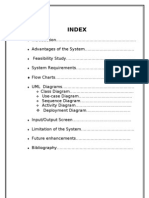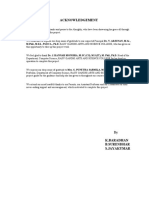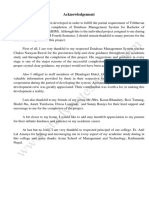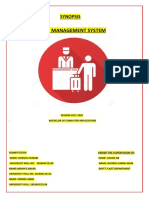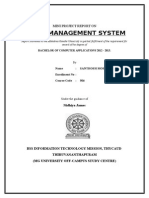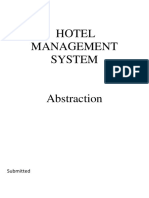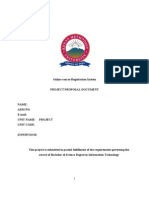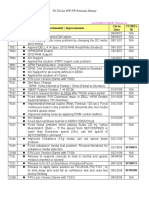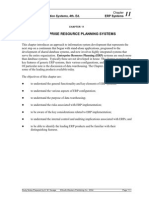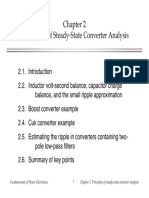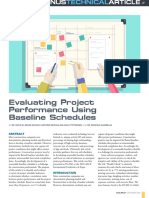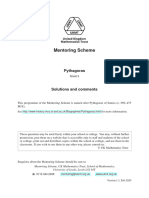1.
Introduction
�1.1 Identity of Client
Hotel Gangasagar
At.Nagoa Beach, Opp.Rasal Hotel,DIU (India)
Contact No. - +917698638939
�1.2 Description of Project
This Hotel Management System has all the features required for all Small & Medium
hotels to function seamlessly. It is very friendly to use and manage all operations of a
Hotel very effectively. This software can be set up for your unique needs. This Hotel
management system has been conceived by blend of seasoned professional. It is geared
up to meet the demands of running a modern Hotel, Restaurant and bar. This system will
give full solution for the Hotel Management. It will work on network so that multiple
users will be able to work on this system simultaneously. It is a comprehensive software
suite consisting of integrated modules for various aspects of hotel management. Hotel
Management System is a software system where the management of entire hotel is
computerized. The hotel management system is designed using visual basic.net as the
rich GUI for front end and MS SQL Server as the secured backend database. In this
project and implementation the details are maintained like customer details, reservation
details, Booking details and billing details The reservation process of reserving rooms for
the customers, canceling the reserved rooms, booking the rooms , vacating the rooms, the
restaurant management, billing process, all are computerized and the management is done
without any difficulty. The reports can be viewed completely and the head of the
management daily or weekly or monthly can review it. For company auditing it will be
more useful.
Main Features are:
1. Hotel, Multiple Banquet Hall, Wedding Garden Reservation.
2. Restaurant Billing (KOT).
3. LAN Chat Module
4. Guests Management
5. Guests Orders Management.
6. Stock Management.
7. Employee's Payroll System and Inventory Management
8. System Logs, Database Backup and Restore, Advanced Reports
�2. Background
�2.1 Description of existing system
Hotel Management involves maintaining various operations of the hotel like Booking or
reservations of the rooms, Cancellation of the rooms, Cash billing, Room service,
Restaurant service, Restaurant billing, Total billing, Travels arrangement etc. The
existing system is a manual one and there is lot of issues like erroneous data, slow
process, lack of security etc. Finding out the final payment amount completely relies on
the hotel manager and if he is absent, it takes a long time to find out the details during
check out and is prone to errors.
Drawbacks of the Existing System
Manual entry consumes more time.
It is difficult to maintain bulk of record in manual.
Restrictions in the users.
Not easy to prepare the daily reports.
Lack of accuracy and error prone.
Overall efficiency is less.
Lot of paperwork.
Non-secure.
No perfect maintenance of report.
No method to trace details
Human errors
The manual system is too slow
Searching is more time consuming
Slow recording, processing and retrieval of customer details
Reliance on paper based work. Paper files consume a lot of the office space
The storing and retrieving mechanism of data wastes materials and human power.
Data that stored in manual format is more vulnerable to damages.
Saving Guest and Employee records manually wastes too many resources (eg.
Paper, pen, ink)
Accessing and sharing of information by different departments is difficult due to
poor information management.
5
Retrieving guest, Employee and transaction record is tedious because searching
mechanism is currently manual
Files are prone to theft unauthorized modification due to low data security levels a
nd standards.
Each time Guest is want to Reserve a room, garden or, Hall the guest must
register all over again this leads to inconsistency, wastage of time and makes
difficult to know the Guest history.
�2.2 Circumstances leading to the current new system
This Hotel ERP System is much more efficient and effective than the current manual
system.
Records searching is very fast.
It is easier to maintain bulk of records.
Easy to prepare the daily reports.
Provides Correctness, Reliability, Efficiency, testability and Portability.
Highly Secure
Perfect maintenance of report and easier generation of bills.
Provides database backup and restore facility.
Having Chatting module for perfect communication between system users.
All records can be updated frequently.
�3. Objective
�3.1 Objective of the project
The main objective behind preparing this project is that to give hotel a complete facility
that a hotel managerial team wants. It even helps the user to handle the managing system
of the hotel properly. And it also gives the customer an easier way to have booking and
other related activities in the hotel. Besides this there are many objectives like:
1)
To manipulate the Hotel transactions with instant confirmation.
2)
To save time and accuracy in work.
3)
To increase efficiency of employee.
4)
For fast access of data.
5)
For secure and smooth running of the program.
6)
For error free, effective and easy for database related works.
7)
Faster Processing of Bills.
8)
To ease staff and admin with facilities for reservation process.
9) To enable sharing of ideas, harmonize and provide timely useful information
on how best to enhance performance.
10) To ease decision making, save time and resources and utilize opportunities of
new technology.
�This project objective is (SMART):S--Specific: - our project Boundary, Business logic requirement depends on Ganga
Sagar Hotel and contains Specifically one Desktop application which will provide
(Inventory, Payroll, Attendance, Reservation (Room, Garden, Hall), Appointment
Scheduler, Chat, Backup and restore, Reports and Advanced Search records),
M--must be Measurable; - If we cannot measure it, we cannot accomplish it.
Measurement is a way of monitoring our progress. So we put different Quality
parameters like Performance, Speed, Error handling and the like. We will use
TDD (Test Driven Development) approach.
A--must be achievable: - Achievable means that it should be out of reach enough to
be challenging but it should not be out of sight, otherwise it becomes disheartening.
So according to the material provided by Ganga Sagar Hotel for the development
purpose and the knowledge we have in Program and Documentation this project will
be achieved without doubt.
Rrealistic: - Our Project is realistic in its scope and functional and non-functional
requirement.
T-Time bounded: - we put a project progress report on the Schedule in every our
Software development life Cycle. And we set time for every deliverables.
10
�4. Analysis
11
�4.1 System Requirement Analysis
4.1.1 Information Gathering
Information gathering is an art of science, The aim of information gathering is to
primarily Develop an understanding of the problem faced by the user and nature of the
operation .it also require to get the suitable solution of the problems .the approach and
manner in which information is gather require persons with sensitivity, common sense
and knowledge of what And when to gather and what channels to use in securing training
and experience that we have.
Information about the current system is studied to know that promotes the introduction of
manual hotel management systems there are many loop present in current system,
information gathering of the project is done by collecting information from the
organization itself, internet On site observation, go to the Organization communicate with
the system users.
4.1.2 Methodology for the project
The software development life cycle model that we used for developing this project is the
agile model.
Agile Development Principles
Iterative Development: our development strategy is Iterative development
which allows the client to direct the development process in order to get the
software features they want. Working software is delivered to the client at
regular, short intervals. Client feedback is used to make changes to the
software specifications at any stage in the development.
Open Collaboration: The backbone of agile development is open, unrestricted
communication between programmers and clients. In addition to working
closely with the clients, the programming team must be able to communicate
freely with each other. Face to face communication is preferred over
specification documents, so working in an open office with no cubicles is
ideal.
Adaptability: Software must be written expecting for future change.
Principles like Don't Repeat Yourself (DRY) are used to facilitate this. In
12
�agile development, changes to the software specifications are welcome even
in late stages of development. As clients get more hands-on time with
iterative builds of the software, they may be able to better communicate their
needs. Also, changes in the market or company structure might dictate
changes in the software specifications. Agile development is designed to
accommodate these late changes.
4.1.3 Data Source
The data source for this project is the primary data source: Employees of the Hotel: Since the Ganga Sagar Hotels Managers are the main
beneficiaries of this project they are one of our data source. Administrators, the Owner of
the Hotel and other Employees such as cashiers etc
Forms: paper forms filled for Guest and Employee Registration and Item Purchase and
transaction reports.
Internet: We used internet for getting tools we will be using to develop this system.
4.1.4 Fact Finding Techniques
Learn from existing documents, forms, reports, and files.
If appropriate, observe the system in action.
Given all the facts that already collected, design and distribute questionnaires
to clear up things that arent fully understood.
Conduct interviews (or group work sessions).
4.1.5 Data Collection Methods
After a simple meeting with the hotel management, we were able to gain more details
and processes that need to be considering in building the system. Requirement gatheri
ng process was performed by using some techniques such as
Interviewing
Observation
Document Analysis
Prototyping
13
�Through this we were able to collect raw data on the System at Ganga Sagar
Hotel where existing reports on the current system were obtained. Verbal
interview techniques were used to interview employees from the hotel.
Interview
Interviewing with the manager, workers and the head of the hotel face to face is
beneficial to the system and clear out many differences regarding requirements
about the system. We found the all requirements that have to be computerized
such as billing details, guest details, room details and hotel staff details. By
refereeing to files and records that have been keeping by the hotel, we got a clear
idea about the required fields. The requirements gathering we have done helped
us in identifying the entities, attributes and the relationships of the scenario of
the hotel and the information we gathered helped us to decide the data that we
should handle in the system database. The functions of the system that is going to
be designed has to be met with the customer requirements and the outcomes of the
functions should have to be addressed the problems that we have encountered
during the requirement gathering phase. The customer requirements identified
Practical Observation
Watching users (in our case Receptionist, finance, Hotel Manager, admin,
Cashier, Store keeper) performing their day to day activities at work We use this
way to check for nonverbal expression of feelings, determine who interacts with
whom, grasp how participants communicate with each other, and check for how
much time is spent on various activities.
Document Analysis
We try to take a look on Forms reports and some files from existing system, to
better understand how the existing system is working, how documents are managed and
accessed.
14
�4.2 System Analysis
4.2.1 Feasibility Analysis
The feasibility study proposes one or more conceptual solution to the problem set of the
project. In software development whatever we think need not be feasible .It is wise to
think about the feasibility of any problem we undertake. Feasibility is the study of
impact, which happens in the organization by the development of a system. The impact
can be either positive or negative. When the positives dominate the negatives, then the
system is considered feasible. In fact, it is an evaluation of whether it is worthwhile to
proceed with project or not. Feasibility analysis usually considers a number of project
alternatives, one that is chosen as the most satisfactory solution. These alternatives also
need to be evaluated in a broad way without committing too many resources.
4.2.1.1 Operational feasibility
The system is operationally feasible as its very easy for the end users to operate it. That
is once the system is deployed, it can operate on any of the operating systems which have
a (.NET) framework installed. Therefore, the system will be designed to be operationally
feasible that if it is deployed, the system will operate in any kind of platforms without
any mal functionalities.
4.2.1.2 Technical feasibility
The system is going to be developed by following the Object Oriented System
Development technique. The system we are going to develop is capable of working in the
current environment of the organization. That means it is possible to use the system with
minimum hardware and software resources. So we can strongly say that it is technically
feasible, since there will not be much difficulty in getting required resources for the
development and maintaining the system as well. All the resources needed for the
development of the software as well as the maintenance of the same is available in the
organization here we are utilizing the resources which are available already.
4.2.1.3 Economic feasibility
This is basically the issue of looking into the feasibility of the project from the angle of
economy. Development of this application is highly economically feasible .The
organization needed not spend much money for the development of the system, they
15
�needs to reduce their cost and improve their income, so that it is cost effective in the
sense that has eliminated the paper work completely. The result obtained contains
minimum errors and are highly accurate as the data is required.
4.2.1.4 Behavioral/Political feasibility
The system working is quite easy to use and learn due to its simple but attractive
interface. User requires no special training for operating the system.
4.2.1.5 Schedule feasibility
All the team members expect that the project will be completed within the time frame
stated, so that the system will be feasible regarding schedule
16
�4.3 Technologies Used
HARDWARE CONFIGURATION
A Computer (i.e. Laptop or Desktop)
Processor
Intel Core Duo 1.8 GHz or more
RAM
1GB or more
Hard Disk
20GB or More
Monitor
14 Color Screen or More
Mouse
3 Buttons
Printer For Report Printing
SOFTWARE CONFIGURATION
Back End
Environment :
Microsoft Visual Studio 2013 and Crystal Report
.Net Framework :
Version 4.5.1
Language
Visual Basic.NET
MS Sql Server 2012
17
�5. System Analysis Tools
18
�5.1 Use Case Diagram
Use Case (UC) diagrams are drawn to summarize who can use an application or system,
and what they can do with the system. They are used to show all of the available system
functionality. Use Case Diagrams have four (4) major elements: Actors, System, Use
Cases, and relationships. Use Case Diagrams represent the functionality of the system
from a top-down perspective.
Use Case diagrams as behavior diagrams are used to describe a set of actions (use cases)
that systems (subject) should or can perform in collaboration with one or more external
users of the system (actors). Each user provides some observable and valuable result to
the actors or other stakeholders of the system.
UC diagrams are used to specify external requirements on a subject (required usage of a
system), the functionality offered by a subject (what the system can do), and the
requirements the specified subject poses on its environment.
Actor identification
In our System we have six Actors which are the following
1.Hotel manager
2.Finance manager
3.Store keeper
4. Receptionist
5. Cashier
6. Administrator
Primary Actor: Administrator
Basic Flow Event
1. Receptionist insert username and Password
2. Receptionist validate
3. System Displays main system Interface(Allowed Content)
4. Receptionist insert valid Guest Information
5. Guest information Successfully inserted
6. Receptionist Select reservation Type
7. System display Available reservation item
8. Receptionist select Available reservation item
19
�9. Receptionist assign Available reservation
Alternative Flow
2. a. Receptionist not validate
2a.1 System Displays error message
4.a Receptionist insert invalid Guest Information
4.a.1 System Displays error message
8.a Receptionist select occupied reservation item
8.a.1 System Displays error message
Primary Actor: Hotel Manger
Basic Flow Event
1. Manager insert username and Password
2. Manager validate
3. System Displays main system Interface(allowed Content)
4. Manager select report
5. System Displays Report list
6. Manager select report type
7. System Generate report
Alternative Flow
2. a. Manager not validate
2a.1 System Displays error message
Primary Actor: Cashier
Basic Flow Event
1. Cashier insert username and Password
2. Cashier validate
3. System Displays main system Interface(allowed Content)
4. Cashier select Restaurant
5. System Displays Restaurant bill
6. Cashier insert order list and amount
7. System Calculate bill
20
�8. System Generate bill
Alternative Flow
2. a. Cashier not validate
2a.1 System Displays error message
Use case: Manage Stock
Primary Actor: Store Kipper
Basic Flow Event
1. Store Kipper insert username and Password
2. Store Kipper validate
3. System Displays main system Interface(allowed Content)
4. Store Kipper select inventory
5. Add inventory items
6. Update inventory items
7. Delete inventory items
Alternative Flow
2. a. Store Kipper not validate
2a.1 System Displays error message
Use case: Manage Finance
Primary Actor: Finance manager
Basic Flow Event:
1. Finance manager insert username and Password
2. Finance manager validate
3. System Displays main system Interface(allowed Content)
4. Finance manager select Employee Information
5. Finance manager Manage Employee Attendance
6. Finance manager make Employee Payroll
7. Finance manager select report
8. System Generate Report
21
�Alternative Flow
2. a. Finance manager not validate
2a.1 System Displays error message
Use case: Manage System
Primary Actor: Administrator
Basic Flow Event:
1. Administrator insert username and Password
2. Administrator validate
3. System Displays main system Interface(allowed Content)
4. Administrator select user management
5. Administrator add users and assign password
6. Administrator take system back up
Alternative Flow
2. a. Administrator not validate
2a.1 System Displays error message
22
�Human Resource
23
�Inventory Management
24
�Reservation
25
�26
�Case Model: Manage System
Use Case Description
Finance:
Manage Employees Attendance
Make employees Payroll
Use a chat Module
View all Financial Reports
Administrator:
Manage user accounts
Assign password to users
Make database backup
Restore Database Backup
Receptionist:
Make reservation process for (Garden, Banquet Hall and Room )
Record Guest Details
Make appointment
Check in and check out Room
Manager:
View all Hotel Report
View Employees Information
Cashier:
Calculate Restaurant Payment
Generate Restaurant bill
Store keeper:
Add new Purchased items into inventory system
Update items in stock
Delete item in stock
27
�5.2 Activity Diagram
Activity diagrams, which are related to program flow plans (flowcharts), are used to
illustrate activities. In the external view, we use activity diagrams for the description of
those business processes that describe the functionality of the business system. Contrary
to use case diagrams, in activity diagrams it is obvious whether actors can perform
business use cases together or independently from one another. Activity diagrams allow
you to think functionally. Purists of the object-oriented approach probably dislike this
fact. We, on the other hand, regard this fact as a great advantage, since users of objectoriented methods, as well as users of functional thinking patterns, find a common and
familiar display format, which is a significant aid for business-process modeling. Because
it is possible to explicitly describe parallel events, the activity diagram is well suited for
the illustration of business processes, since business processes rarely occur in a linear
manner and often exhibit parallelisms. Activity diagrams can be developed in various
degrees of detail. They can be refined step by step. In the external view, activity
diagrams, just like use case diagrams, exclusively represent business processes and
activities from the outside perspective. Refining diagrams does not mean describing
process details that are performed within the business system, which often leads to an
unnoticed shift to the internal view.
28
�Receptionist
29
�Manager
30
�Cashier
31
�Stock
32
�Finance
33
�Administrator
34
�5.3 Sequence Diagram
A sequence diagram is a interaction diagram that shows how processes operate with one
another and in what order. It is a construct of a Message Sequence Chart. A sequence
diagram shows object interactions arranged in time sequence. It depicts the objects and
classes involved in the scenario and the sequence of messages exchanged between the
objects needed to carry out the functionality of the scenario. Sequence diagrams are
typically associated with use case realizations in the Logical View of the system under
development. Sequence diagrams are sometimes called event diagrams, event scenarios.
A sequence diagram shows, as parallel vertical lines (lifelines), different processes or
objects that live simultaneously, and, as horizontal arrows, the messages exchanged
between them, in the order in which they occur. This allows the specification of simple
runtime scenarios in a graphical manner.
35
�Receptionist
36
�Manager
37
�Cashier
38
�Inventory
39
�Finance
40
�Administrator
41
�5.4 ER-Model
It is a data model for describing the data or information aspects of a business domain or
its process requirements, in an abstract way that lends itself to ultimately being
implemented in a database such as a relational database. The main components of ER
models are entities (things) and the relationships that can exist among them, and
databases.
42
�5.5 Data Flow Diagram
A dataflow diagram is the graphical representation of a system's data and how the
processes transform the data. DFDs approach a system from a data perspective.
They are commonly used to document the process of current and required systems. The
dataflow diagram of the system would describe all the processes involved in the College
Management System. The diagram summarizes the system more clearly than the context
diagram. They are constructed using four major components, External Entities, Data
Stores, Process, and Data- Flows. External Entities represent the source of data as input
to the system. They are also the destination of system data. They are represented by the
ellipses with names. Data Stores represent stores of data like computer files and databases
within the system. They are drawn as open-ended rectangles and uniquely identified by
letters followed by a number. Process represent activities where data is manipulated,
retrieved, transferred, or stored in a particular way. Processes transform input data into
output data. They are shown as larger rectangles with a numeric identifier in a box at the
top left corner. The box would indicate the process location and also the process name.
Data Flow represents the movement of data from one component to the other. An arrow
indicates dataflow (data in motion), and it is a pipeline through which information flows.
Data flows are shown one-way only, and external entities are shown as dotted lines.
43
�44
�45
�46
�47
�48
�49
�50
�Opening a new room DFD :
Check-In of a new customer DFD :
51
�Record Modification DFD :
52
�Check out of a customer DFD :
53
�Listing of Customers DFD :
54
�Generating Bill of a Customer DFD :
55
�List of All Records DFD :
56
�6. Design
57
�6.1 System Architecture
The architecture of the proposed system is very important to explain the processes of the
system. The initial design will help the development of the system as it goes on. The
structure design will explain the overall process of the proposed system.
58
�6.2 Database Design
Database Tables
59
�60
�61
�62
�63
�64
�65
�66
�67
�68
�69
�70
�71
�72
�73
�74
�6.3 Interface Design
Login Form
75
�Main Form
Guest Form
76
�Purchased Inventory Form
77
�Registration Form
78
�Room Form
79
�Chat Server Form
80
�Chat Client Form
81
�Reservation Form
82
�83
�Check IN Form
84
�Check Out Form
85
�Stock Form
86
�Restaurant Billing Form
87
�Order Form
88
�Others Transaction Form
Employee Form
89
�Attendance Form
90
�Payment Form
91
�7. Testing
92
�Testing is a process of executing a program with the intent of finding in error. Debugging
is the process of loading the exact cause of an error in removing that cause. Software
testing is a critical element of software quality assurance and represents the ultimate
review of specifications, design and code generation. These techniques provide
systematic guidance for designing tests that: Exercise the internal logic of software
components, and exercise the input and output domains of the programs to uncover the
errors in program function, behavior and performance.
Testing Methods that are use
Black Box Testing:- We used Black Box testing. We give different different type of
inputs and check the output.
White Box Testing:- In this testing, we check all the loops and structure. We give input
according to the the loops and structure and check the output.
Unit Testing:- In this testing, whenever a module is finished we check it individualy,
means all the functions are checked individualy.
Interface Testing.
-We check if all the interactions between these applications are executed properly or not.
-Errors are handled properly or not.
-If database returns any error message for any query by application then it be should
catch and display these error messages appropriately to users.
1. Interrogation Testing: - When unit testing is finished, we integrate functions and then
check the function that they are working properly or not.
2. Performance Testing:We test our project on different internet connection speed. In load testing test if user
wants to perform so many functionalities at the same time, large input data from users,
Simultaneous connection to DB, heavy load on specific pages etc.
93
�7.1 Scope of Testing
In our project, we had first gone for unit testing strategy. In which we test for the
functionality of each function, after that we performed Integration testing where we
integrated them all and tested them together.
7.2 Test Plan:
We have gone for unit testing and integral testing. So, we have initially concentrated on
unit testing and for that we spend some time whenever we developed any new functions.
This has been done during coding time as well as after the design whenever we use them.
After the completion of unit testing, we have moved to integration testing and we
completed it in one day.
No. SDLC PHASE
TESTING ACTIVITY
Requirement
Review
Design
Review
Implementation
Code Review
Unit Testing
Component Testing
Integration Testing
Testing
Robustness
Compatibility
Load testing
Security
Regression
Deployment/Maintenance
Acceptance testing
Regressions
94
�7.3 Test Case Design
S. Test Case
Expected
Actual
Stat
Result
Result
us
Reached
pass
Description
o
1. Select Usertype and Enter username and Go to
password
Home
to
Page
Home
Page
2. Change Password
Password
Passwor
should be
changed
changed
and go to
and
login page
reached
Pass
to login
page
3. Save,update,delete Master entries
4. Save,update,delete Transaction Entries
and Restaurant Billing
Operation
Pass
should be
Successf
Perform
ul
Operation
Successf
should be
ul
Pass
Perform
5. See user information
Only
Successf
admin
ul
Pass
user
6. Employee Registration
7. User registration
8. Employee(Advance
95
Only valid
Successf
registration
ully.
Only valid
Successf
registration
ully.
Operation
Successf
Pass
Pass
Pass
�Entry,Attendancen,Payment,Generate
should be
slip)
Perform
9. Records Searching
ully.
Operation
Successf
should be
ully.
Pass
Perform
1
Reports and Receipts Generation
0.
Operation
Successf
should be
ully.
Pass
Perform
7.4 Sample Test Data and Result
S. No.
Test Case
Test Data
Result
1.
Select Usertype
Usertype- admin
Successfully login
and Enter user
username- admin
name & password
password-admin
for login
2.
Select Usertype
username- raj12356
Message-invalid
and Enter user
password-67875
username or
name & password
password
for login
3.
Add the
Userid,contactno,emai
Successfully
users(Users
Added
Registration)
name,password,userty
pe
4.
Add the
Userid,contactno,emai
Message-errors
users(Users
l,Name,usertype
enter the password
Registration)
96
�8. Limitations
1. If there is a power failure while making a reservation, all the information has to
be enter again.
2. If there is a power cut while there is a check-in or check-out, the guest need to
wait for full server startup, which is time consuming.
3. Failure of Server PC will make the all computers (Clients) down which were
connected to the server and Software on client PC wont work until server PC
started again.
4. No auto backup and online backup option available, all information will be lose
in case of disk failure.
97
�9. Future Scope
In future scope our software could be further enhanced by providing our customers with
the facility of booking more than one rooms at the same time and keeping his/her Guest
ID the same .Apart from that in future our software can also be used for hotels that
provide both lodging and Restaurant facilities with billing in multiple currencies, in such
case our software would also keep a record of food supplements and recruited staffs in
our database. The inclusion of these features would definitely make our software highly
demanding and would be a grand success in practical field.
Features to be considering for the future aspects:
1. Billing in multiple currencies
2. Multiple Hotels Management
3. SMS Notifications Module
4. Booking of Multiple Rooms at a time to same guest
98
�10. Conclusion
It has been a matter of immense pleasure, honor and challenge to have this
opportunity from Ganga Sagar Hotel to take up this project and complete it
successfully. While developing this project I have learnt a lot about hotel
management, I have also learnt how to make it user friendly (easy to use and
handle) by hiding the complicated parts of it from the users. During the
development process I studied carefully and understood the criteria for making a
software more demanding, I also realized the importance of maintaining a minimal
margin for error.
99
�11. List of Figures and Tables
100
�Figures:
S.No.
Figure Name
Page
No.
Use Case diagram for Human Resource
23
Use Case diagram for Inventory
Management
24
Use Case diagram for Reservation
25
Use Case diagram for Manage System
26
Activity diagram for Receptionist
29
Activity diagram for Manager
30
Activity diagram for Cashier
31
Activity diagram for Store keeper
32
Activity diagram for Finance
33
10
Activity diagram for Admin
34
11
Sequence diagram for Receptionist
36
12
Sequence diagram for Manager
37
13
Sequence diagram for Cashier
38
14
Sequence diagram for Store keeper
39
15
Sequence diagram for Finance
40
16
Sequence diagram for Admin
41
17
ER Model
42
18
0 Level DFD
44
19
1 Level DFD (Admin)
45
101
�20
1 Level DFD (Receptionist)
46
21
1 Level DFD (Normal User)
46
22
2.1 Level DFD (Admin)
47
23
2.1 Level DFD (Receptionist)
48
24
2.1 Level DFD (Normal User)
49
25
2.2 Level DFD (Admin)
50
26
Check-In of a new customer DFD :
51
27
Record Modification DFD :
52
28
Check out of a customer DFD :
53
29
Listing of Customers DFD :
54
30
Generating Bill of a Customer DFD :
55
31
List of All Records DFD :
56
32
System Architecture
58
102
�Tables :
S.No.
Table Name
Page no.
Activation
59
AdvanceEntry
59
Category
59
Category_Liquor
59
CheckIn_Room
60
Checkout_Room
60
Dish
61
EmployeeAttendance
61
EmployeePayment
61
10
EmployeeRegistration
62
11
ExtraBed
62
12
ExtraPerson
62
13
Garden
62
14
Guest
63
15
Guest_Docs
63
16
Hall
63
17
Hotel
64
18
IDType
64
19
Laundry_BillInfo
64
103
�S.No.
Table Name
Page no.
20
Laundry_Master
64
21
LaundryServices
64
22
Liquor
65
23
Liquor_Rate
65
24
Liquor_Volumn
65
25
Logs
65
26
PurchasedInventory
65
27
R_Table
66
28
Registration
66
29
Reservation
66
30
Reservation_Garden
67
31
Reservation_Hall
68
32
Restaurant_BillingInfoKOT
68
33
Restaurant_OrderedProduct
69
34
Restaurant_OrderedProductBillKOT
69
35
Restaurant_OrderedProductKOT
70
36
Restaurant_OrderInfo
70
37
Restaurant_OrderInfoKOT
70
38
Room
70
39
Room_OrderedProduct
71
40
Room_OrderInfo
71
41
RoomType
71
104
�42
Stock
71
43
Tax
72
44
TaxPayment_R
72
45
TaxPayment_RGH
72
46
Temp_Reservation
73
47
Temp_Stock
73
48
TempRestaurant_OrderedProductKOT 73
49
TempRestaurant_OrderInfoKOT
74
50
Trans
74
105
�12. Bibliography
1. VB.NET Complete reference and Black Book
2. Software Engineering Roger Pressman, Pankaj Jalote.
3. Database Management Book- Korth and Sudharshan
4. www.stackoverflow.com
5. http://msdn.microsoft.com/en-us/library/2x7h1hfk.aspx
6. http://www.tutorialspoint.com/
106






